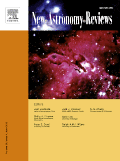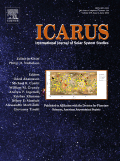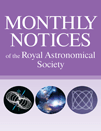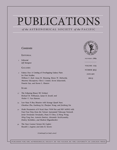
Frontiers in Astronomy and Space Sciences
metrics 2024
Innovating Research to Expand Our Celestial Understanding
Introduction
Frontiers in Astronomy and Space Sciences is a leading open access journal published by FRONTIERS MEDIA SA, based in Switzerland. Since its inception in 2015, this journal has provided a dynamic platform for researchers, professionals, and students to disseminate their findings across a wide spectrum of topics within the field of astronomy and astrophysics. With an impressive 2023 Impact Factor reflecting its relevance and contribution to the scientific community, it ranks in the Q2 category in Astronomy and Astrophysics, demonstrating a solid reputation among peers. The journal's commitment to open access ensures that all published research is freely available, fostering greater collaboration and knowledge sharing among astronomers worldwide. With a diverse range of articles spanning from theoretical investigations to observational studies, Frontiers in Astronomy and Space Sciences is an essential resource for anyone seeking to explore the wonders of the universe and share innovative ideas that push the boundaries of our understanding.
Metrics 2024
 0.64
0.64 2.60
2.60 2.80
2.80 31
31Metrics History
Rank 2024
Scopus
IF (Web Of Science)
JCI (Web Of Science)
Quartile History
Similar Journals

EXPERIMENTAL ASTRONOMY
Fostering Collaboration for Astronomical BreakthroughsEXPERIMENTAL ASTRONOMY, published by Springer, stands as a pivotal journal in the fields of Astronomy and Astrophysics as well as Space and Planetary Science. With an impressive Scopus ranking and a Q2 category as of 2023, the journal is recognized for its impactful contributions to experimental techniques and observations in astronomy. Covering a broad spectrum of topics from cosmic phenomena to planetary exploration, it serves as a vital platform for researchers, professionals, and students to disseminate and discuss innovative ideas and findings. The journal has evolved through various convergence years since its inception in 1989 and continues to thrive, fostering an environment for academic pursuit and collaboration. Though not an open-access journal, its rigorous peer-review process ensures high-quality publications that are essential for advancing the scientific community's understanding of the universe.

NEW ASTRONOMY REVIEWS
Exploring the Cosmos: Your Gateway to Cutting-Edge Astronomical InsightsNEW ASTRONOMY REVIEWS, published by Elsevier Science Ltd, stands as a premier journal in the field of Astronomy and Astrophysics as well as Space and Planetary Science. Established in 1998 and operating until 2024, this journal has consistently maintained a distinguished reputation, reflected in its Q1 categorization in both subject areas for 2023. It holds an impressive Scopus ranking, placed #6 out of 104 in Earth and Planetary Sciences and #7 out of 90 in Physics and Astronomy, showcasing its critical impact with a percentile rank of 94th and 92nd, respectively. Although not an open access journal, it provides vital insights and comprehensive reviews that are essential for researchers, professionals, and students eager to advance their knowledge in contemporary astronomical research and theories. With rigorous peer review and a commitment to high-quality publications, NEW ASTRONOMY REVIEWS is an indispensable resource for the scientific community striving to uncover the mysteries of the universe.

SOLAR SYSTEM RESEARCH
Bridging Science and Discovery in AstronomySOLAR SYSTEM RESEARCH, published by Pleides Publishing Inc, offers a comprehensive platform for the exploration and dissemination of scientific knowledge in the fields of Astronomy, Astrophysics, and Space and Planetary Science. With its origins tracing back to 1969, this journal provides a vital resource for researchers and professionals seeking to deepen their understanding of the solar system's complexities, including planetary formation, extraterrestrial geology, and the dynamics of celestial bodies. Although categorized in the Q4 quartile for both relevant disciplines, SOLAR SYSTEM RESEARCH remains committed to publishing high-quality research that contributes to advancing contemporary scientific discourse. Dedicated to fostering collaboration and innovation, the journal is indexed in Scopus and adheres to rigorous academic standards, making it an essential resource for students and professionals alike pursuing the latest developments in solar system studies.

Journal of Cosmology and Astroparticle Physics
Connecting Researchers to the Heart of AstrophysicsThe Journal of Cosmology and Astroparticle Physics (ISSN: 1475-7516) is a premier publication in the field of astronomy and astrophysics, dedicated to advancing our understanding of the cosmos through innovative research. Published by IOP Publishing Ltd in the United Kingdom, this journal has established itself as a vital resource for researchers, professionals, and students alike, with an impressive Scopus rank of #11/90, placing it in the top 12% of its field. The journal aims to foster the dissemination of groundbreaking studies related to cosmology, dark energy, particle physics, and the universe's fundamental structure, making it a key player in shaping contemporary astrophysics discourse. With a Category Quartile of Q2 as of 2023, it continues to attract high-quality contributions that enhance scholarly dialogue. As an accessible platform, it engages a diverse audience interested in the frontiers of astrophysical research, encouraging collaboration and knowledge sharing among the global scientific community.

Serbian Astronomical Journal
Connecting Researchers to the Wonders of the UniverseSerbian Astronomical Journal, published by the Astronomical Observatory Belgrade, serves as a significant platform for research and innovation within the field of astronomy and astrophysics. With an established publication history since 1992 and an Open Access model, the journal ensures that its cutting-edge research is accessible to a global audience. The journal is recognized for its contribution to the scientific community, evidenced by its solid position in the 2023 Scopus category quartiles, ranking Q3 in Astronomy and Astrophysics. This positions it among notable journals in the discipline, despite being at the 18th percentile of its category rankings. Researchers, professionals, and students will find in Serbian Astronomical Journal a valuable resource for disseminating findings, exploring new discoveries, and engaging with contemporary challenges in astronomy. As the journal continues to evolve, it remains dedicated to advancing the knowledge and understanding of the universe.

Advances in Astronomy and Space Physics
Charting New Territories in Astrophysics and Beyond.Advances in Astronomy and Space Physics is an esteemed journal dedicated to the exploration and dissemination of research in the expansive fields of astronomy and space science. Published by Taras Shevchenko National University of Kyiv, this journal provides a platform for researchers, professionals, and students to share groundbreaking studies and innovations. With an ISSN of 2227-1481, it covers a wide range of subjects including astrophysics, planetary sciences, and space exploration technologies, thereby fostering interdisciplinary collaboration. Although not an Open Access journal, it maintains a commitment to high-quality, peer-reviewed content that contributes significantly to the advancement of scientific knowledge. The journal's mission is to promote sustainable practices in space research while also exploring the implications of discoveries on Earth and beyond. By maintaining rigorous publication standards, Advances in Astronomy and Space Physics aims to serve as a critical resource for those involved in the ever-evolving study of our universe.

ICARUS
Illuminating the Universe Through Rigorous Research.ICARUS is a prominent peer-reviewed journal dedicated to advancing knowledge in the realm of Astronomy and Astrophysics, as well as Space and Planetary Science. Published by Academic Press Inc, Elsevier Science, this esteemed journal has been contributing to the scientific discourse since 1962 and will continue to do so well into 2024. With an impressive impact factor placing it in the Q2 quartile, ICARUS ranks among the top journals in its field, standing appropriately at #22 out of 90 in Astronomy and Astrophysics and #27 out of 104 in Space and Planetary Science according to Scopus metrics. Researchers, professionals, and students alike benefit from its comprehensive scope, which encompasses a wide array of topics related to planetary processes, space exploration, and astrophysical phenomena. Although it does not currently offer open access, the journal remains a critical resource for scholars seeking to disseminate their findings and engage with cutting-edge research in the exciting fields of astronomy and planetary science.

MONTHLY NOTICES OF THE ROYAL ASTRONOMICAL SOCIETY
Charting New Frontiers in Astrophysical Research.The MONTHLY NOTICES OF THE ROYAL ASTRONOMICAL SOCIETY (MNRAS), published by Oxford University Press, serves as a premier platform for the dissemination of significant research in the fields of Astronomy, Astrophysics, and Space and Planetary Science. Established in 1913 and with an impressive impact factor reflected in its 2023 Q1 rankings—13th in Earth and Planetary Sciences and 14th in Physics and Astronomy—this journal is renowned for its rigorous peer-reviewed articles, fostering advancements in our understanding of the universe. Researchers, professionals, and students alike benefit from its rich content, which spans a vast array of topics within its scope, from stellar dynamics to planetary formation. While the journal does not currently offer Open Access options, the scholarly contributions published herein are invaluable for pushing the boundaries of contemporary scientific inquiry and ensuring that the latest findings reach an engaged audience globally.

SOLAR PHYSICS
Pioneering Solar Research: Bridging Theory and ObservationSOLAR PHYSICS, published by SPRINGER, serves as a pivotal platform for the dissemination of groundbreaking research in the fields of Astronomy and Astrophysics, as well as Space and Planetary Science. With an impressive impact factor and ranked Q2 in both categories as of 2023, this esteemed journal has become integral for scholars seeking to advance their knowledge in solar phenomena and related disciplines. Originating from the Netherlands and converging from 1967 to 2024, SOLAR PHYSICS features a diverse array of articles, from observational studies to theoretical analyses, contributing significantly to our understanding of solar activity and its influence on the heliosphere and beyond. Researchers, professionals, and students alike will find this journal an indispensable resource for current trends and comprehensive insights in solar research.

PUBLICATIONS OF THE ASTRONOMICAL SOCIETY OF THE PACIFIC
Illuminating the Cosmos with Groundbreaking ResearchPublications of the Astronomical Society of the Pacific is a prestigious journal dedicated to advancing the fields of Astronomy and Astrophysics, as well as Space and Planetary Science. Published by IOP Publishing Ltd, this influential journal plays a critical role in disseminating groundbreaking research and innovative findings. With an impressive Q1 ranking in both related categories according to the 2023 metrics, it is recognized among the top journals in its field. As a vital resource for researchers, professionals, and students alike, the journal covers a range of topics relevant to current astronomical research from 1996 to 2024. Although it does not offer open access options, the journal is highly regarded in academic circles, evidenced by its competitive ranking in Scopus—20th in Astronomy and Astrophysics and 26th in Space and Planetary Science. This commitment to excellence ensures that it remains an essential platform for sharing the latest insights in the ever-evolving universe.